

The excavation of Carsuale has occurred in a sporadic manner from the 16th century, and finds from the site are consequently now widely dispersed. Some of these are listed below, grouped by their current locations. Where the likely find spot is known, there are cross-references in the page on the Walk around Carsulae.
Finds in the Antiquarium
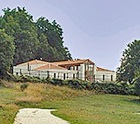
Statue of Dionysus (1st century AD)
This statue, which probably came from the theatre, has recently been restored.
Fragments from a Statue of the Emperor Claudius (ca. 50 AD)
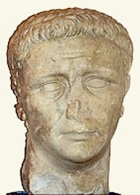

This monumental statue (twice life-size) stood in the forum. The head and a knee survive and are exhibited here. [This statue, which has been recut from a statue of the seated Caligula in the guise of Jupiter, was probably part of a Julio-Claudian cycle.]
[Eric Varner: The colossal Caligula/Claudius was discovered together with a Julio-Claudian female portrait near a building whose plan suggests an association with the Augustales (Dareggi (1982) 12 and n. 104) [or an Augusteum]
Link to the Augusteum at Ocriculum
Lead coffin (1st century AD)
This coffin, which belonged to a baby girl, was found near the mausoleums outside the Arco di San Damiano. It contained her jewellery: a necklace and earrings made of gold.
Finds in Palazzo Cesi, Acquasparta
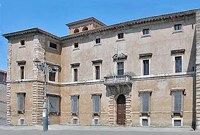
Duke Federico II Cesi organised the first excavations on the site in the 16th century. His primary aim seems to have been to secure Roman artefacts with which to adorn Palazzo Cesi, Acquasparta and some important finds from the site are still to be found there.
Duovir from Carsulae (late 1st century BC)
This inscription (CIL XI 4575), which dates to the late 1st century BC, commemorates ‘[---]lius Ti(beri) f(ilius) Pup(inia) Clemens’ as ‘IIvir iure dicundo Carsulis sex(ies?)’. Note that:
-
✴The father and brother of this individual, who were both recorded in the inscription, both belonged to the Clustumina while he belonged to the Pupinia. This suggests that he belonged to a local family but that, for whatever reason, he had changed his tribe.
-
✴If the completion ‘sex(ies)’above is correct, then he had served as IIvir iure dicundo at Carsulae six times.
Inscription from the Mausoleum of the Gens Furia (1st century AD)
An inscription (CIL XI 4572), which dates to the 2nd half of the 1st century AD. commemorates members of the gens Furia, has the same curvature as the mausoleum outside the Arco di San Damiano and almost certainly belonged to it. It commemorates a father and son, both called Caius Furius Tiro and both assigned to the Clustumina, each of whom had served as quattuorvir quinquennalis. The dedicants were Lucius Nonius Asprenas (who had served as quattuorvir) and two ladies from the gens Furia. this is the earliest of a series of inscriptions that record quattuorviri at Carsulae.
Inscriptions in honour of Valerian and Gallienus (ca. 260 AD)
The inscribed bases of two statues in honour (respectively) of the Emperor Valerian (253-60) and his son, the Emperor Gallienus (253-68) almost certainly came from the forum.
[An inscription in Palazzo Cesi, Acquasparta commemorates the first gladiatorial games in the amphitheatre.]
Finds in Cesi
These finds are cross-referenced in the page on the Walk around Cesi.
Cippi Carsulani (1st century BC - 1st century AD)
These distinctive funerary reliefs, which were common in Carsulae, are usually in the form of rectangular travertine slabs. They often feature representations of the gates of Hades and of leather shields of the type used by Amazons.
Examples can be seen in the facades of:
-
✴Sant’ Andrea; and
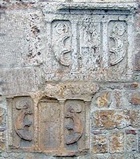
-
✴Santa Maria di Fuori.
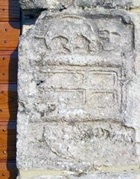
Finds in San Michele Archangelo
This church, which used to house an archeological collection, still contains the inscribed bases of two statues:
-
✴The inscription (CIL XI 4579 ) on one of them refers to a statue that was commissioned by the decuriones in honour of Titus Calvisius, son of Titus, a benefactor of the collegia iuvenum (school). His administrative posts are listed as: augur quinquennale; quattuorvir aedile; curator pecuniae frumentariae; quaestor publicus aerarii; and quaestor pecuniae publicae. (These last three positions were related to the finances of the municipium).
-
✴The inscription (CIL XI 4582 ) on the other refers to a statue in honour of [the magistrate who financed the restoration of an aqueduct].
Finds in San Gemini
An inscription (CIL XI, 4580 ) from the base of a statue that is now in Palazzo Comunale indicates that the statue itself was erected by the collegia iuvenum (school) in honour of one of its patrons.
A fragment of a long inscription(CIL XI, 4593) in the right wall of the ex-church of Santo Stefano (which is now private property), refers to the cults of Nemesis (the goddess of divine justice) and Silvanus (a spirit of the woods).
Finds in Spoleto
Following sporadic finds in the 19th century, Archbishop Giovanni Sabbioni of Spoleto organised more systematic excavation in 1851.
[A bust attributed to Maecenas, which was found on the site in 1829, is now in Palazzo Vescovile, Spoleto ?]
[A mosaic floor depicting marine scenes, which was discovered in the baths in 1783, is now in Spoleto ?]
Sarcophagus of Pontia (early 4th century)

The sarcophagus is now in Room 1 of the Museo del Ducato di Spoleto, Spoleto.
Finds in Museo Archeologico, Tern
There are a number of finds from Carsulae in the Museo Archeologico, Terni.
Lions (1st century BC)
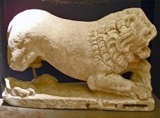
Sarcophagus (3rd century AD)
This marble sarcophagus was found in 1912. The long side is striated and contains a central relief [more] and images of the deceased who are identified by inscription as Terentius e Terentia.
Sarcophagus (3rd century AD)
This travertine sarcophagus was documented in the 18th century. The long side has a central inscription that refers to the deceased as a quattuorvir quinquennalis who died at the age of 57, with reliefs of horse-drawn chariots to the sides of it.
Other Finds from Carsulae
In 1913, a lyrical funerary inscription dedicated to a youth called Sentius was found near the mausoleums outside the Arco di San Damiano. It records that he died three months before his eighteenth birthday: "Pietas cognomine dictus, surrupuit menses tres mihi luna suo". The inscription is now in the Museo Nazionale, Rome.
Return to the home page on Carsulae.

